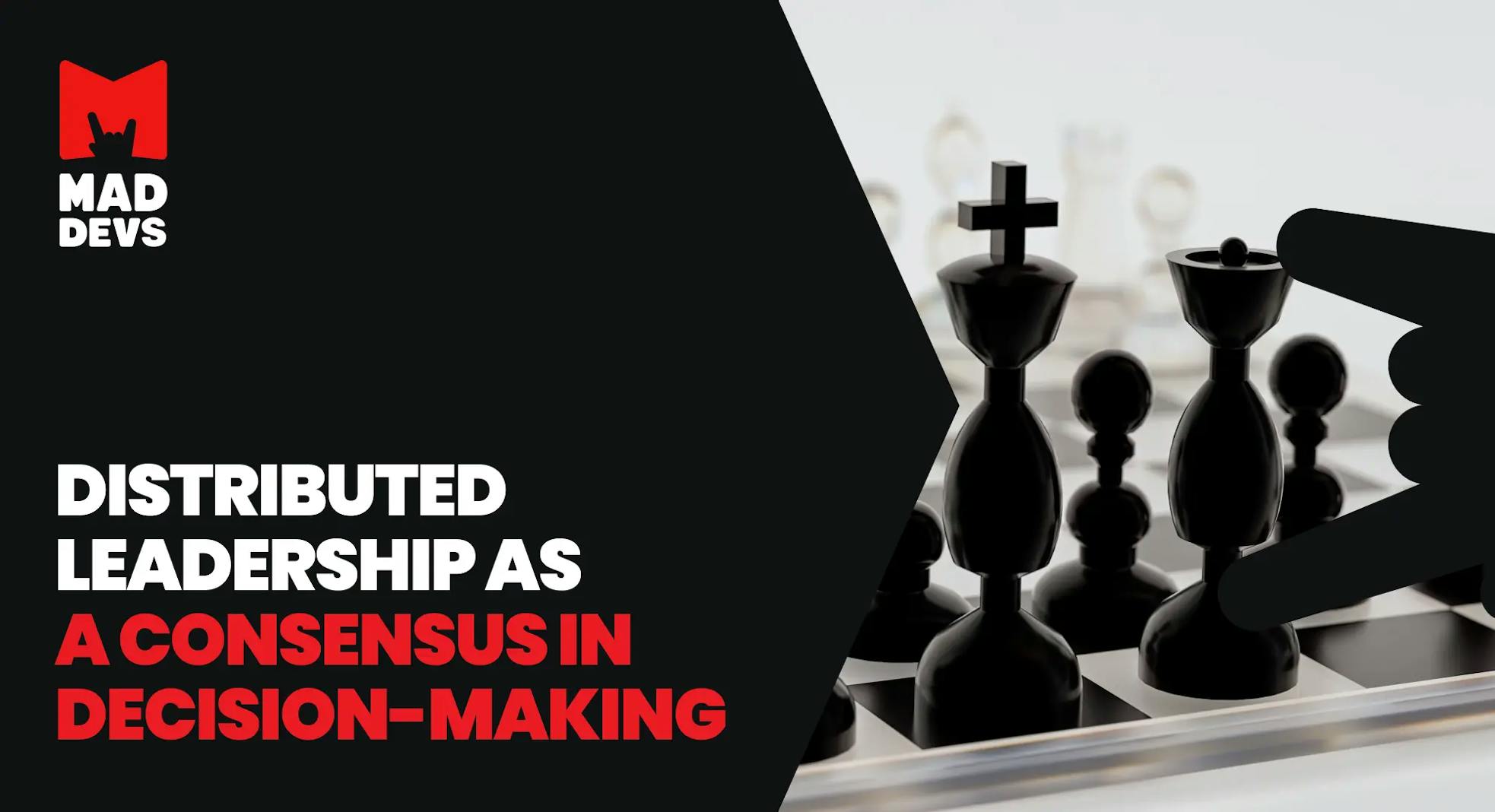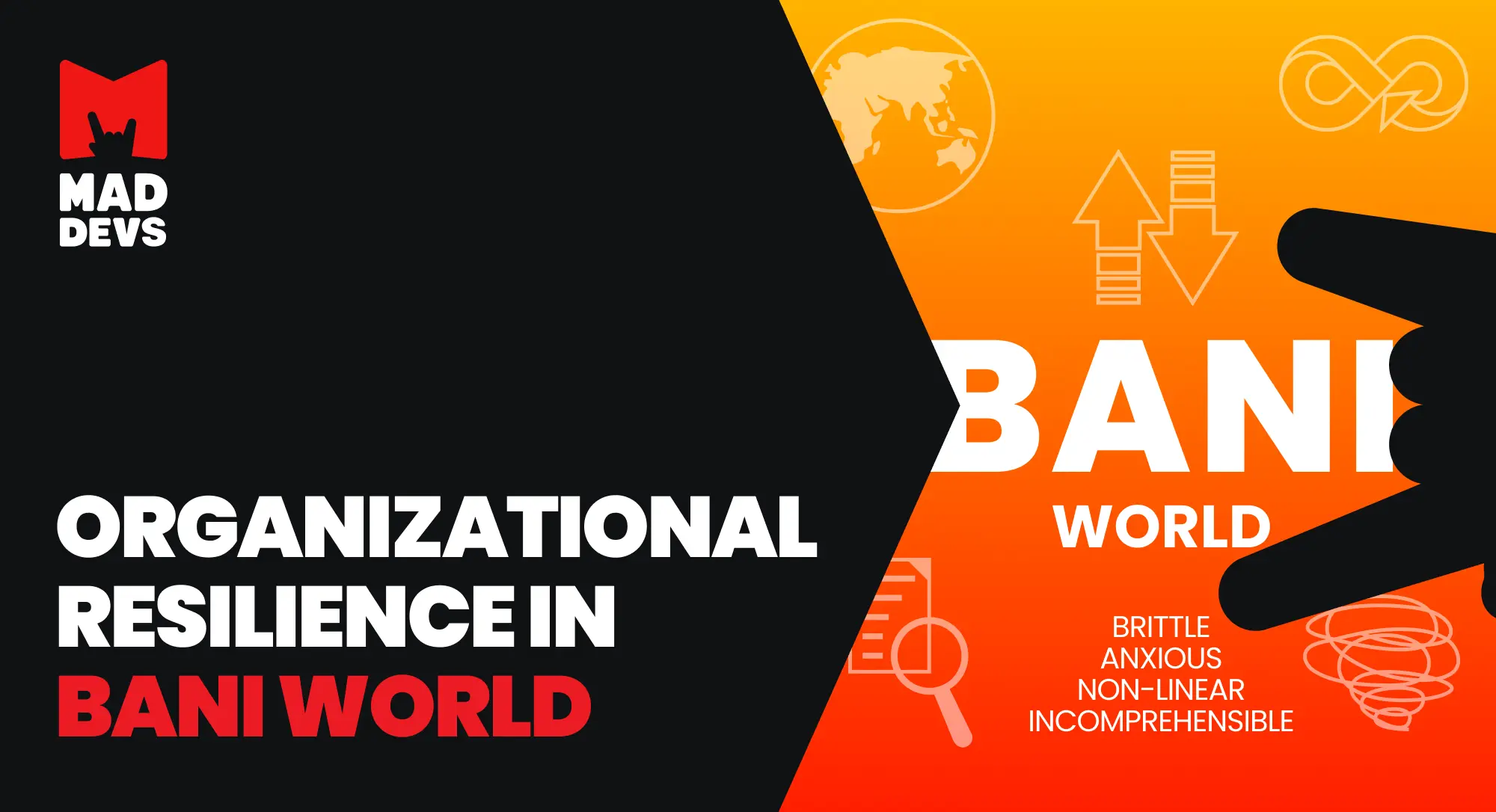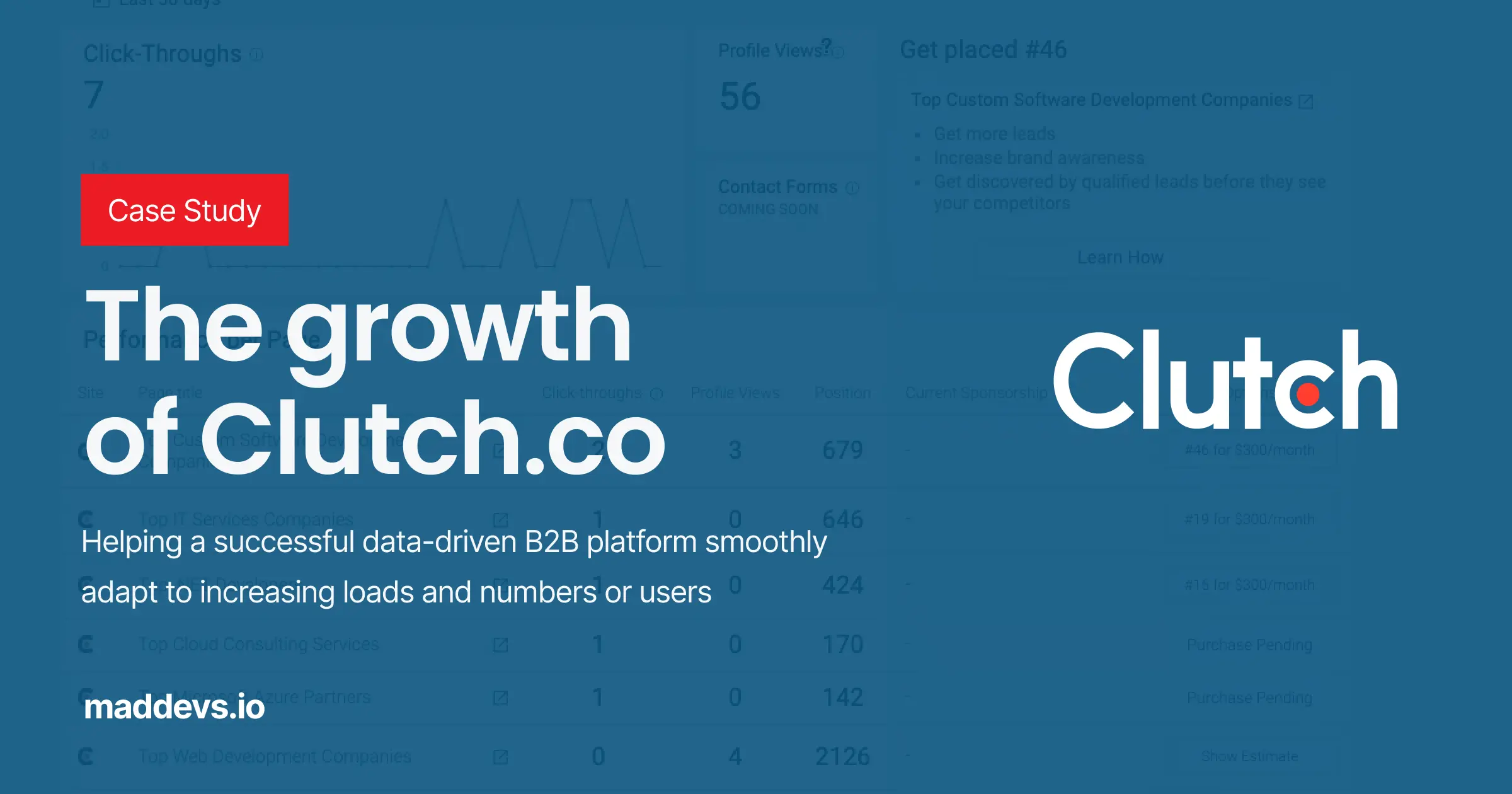The new wave in the IT sphere is a new form of shared leadership—distributed leadership. It is no longer enough to have 30-year strategic plans or even 5- or 10-year roadmaps to guide a company into the future. Strategic thinking and working in flexible teams allow companies to respond to changing technology and external risks such as geopolitical conflict, pandemics, and climate change.
Increasingly, companies are moving away from command-and-control leadership in favor of distributed management, which emphasizes giving people autonomy and using noncoercive methods to ensure alignment.
Within our company, we also try to apply distributed leadership in practice. In this article, we will look at what distributed leadership is and share the experience of our company and others.
Mad Dev's about distributed leadership
As Mad Devs CSO & co-founder I would like to share our company experience about distributed leadership.
Service development is a pretty complicated business. Therefore, managing a company that wishes to become an active market participant is laborious and complex. Working with clients, managing processes, and meeting deadlines are all part of this. In addition, you need to be able to sell your software, and for this, you need to invest in marketing, find new customers and retain old ones.
Regardless, service development is a sustainable business. Especially if you find the right approach to it. Therefore, it is essential to find a method of managing a company in which the right to make decisions will not be concentrated in the hands of one person, especially if they cannot be challenged.
Therefore, in Mad Devs, we divided responsibilities equally so that no one had complete control over anything. And if a person starts making wrong decisions that can harm the company, then there is an opportunity to stop this, somehow influence or block this decision.
Thanks to distributed leadership, there is a consensus in decision-making, which is one of the most effective ways to resolve conflicts. Thus, all parties come to a single solution that suits everyone. In distributed leadership, a consensus appears more often, which makes it possible to form more effective, sober, balanced management decisions.
The first results were visible immediately after the practice was implemented. The beginning of the Mad Devs was the eternal founder's disputes until it was possible to develop a consensus opinion that would satisfy everyone. Now it is less, as many things are on stream. Now we are trying to facilitate distributed leadership for other departments on different levels. What is the purpose of implementation? Do not depend on the opinion of one person. Since a person in the work process is the most vulnerable link, which is influenced by both internal and external factors. It is important that decisions are made openly and soberly.
Due to the implementation of distributed leadership, more and more employees are used to being autonomous and empowered. The younger generation is used to expressing their creativity and autonomy in a networked world. Those opportunities are available to them in modern organizations.
After a long road to avoiding pitfalls while moving to a distributed leadership model, Oleg offers a list of advantages:
- Increasing the likelihood of making effective and sober management decisions.
- Distributed leadership practice facilitates the professional growth of participants.
- Distributed leadership nurtures a sense of ownership of what participants do.
Understanding distributed leadership
MIT Sloan professor Deborah Ancona defines distributed leadership as collaborative, autonomous practices managed by a network of formal and informal leaders across an organization. This practice is based on those who share leadership responsibilities and accountability with the relevant skills or expertise.
Moreover, it is based on three key ideas:
- Leadership results from the interaction of multiple individuals or groups. An individual's actions don't determine the outcome.
- It is important that expertise is distributed across an organization and not confined to a few key personnel.
- It should be open to those who were previously excluded.
This approach is a diverse and broad concept and shares some overlap with democratic, collaborative, and shared leadership. The model also acknowledges individuals' diversity, maturity, and interdependence and how deep cultural values influence democratic governance.
Diane R. Dean, Associate Professor at Illinois State University, to summarize the various theories she created eight principles of distributed leadership:
- Shared responsibility—leadership is the total behavior of many individuals.
- Shared power and authority—segment participation, empowerment, dialogue, and cooperation.
- Synergy—as a result of shared decision-making, participants form strong relationships based on mutual understanding.
- Leadership capacity—depends on its employees' collective knowledge. Goal setting is encouraged, and passive behavior is discouraged.
- Organizational learning—collectively managed organizations must create, share, and apply knowledge similarly.
- Equitable and ethical climate—involves a wide range of stakeholders by its very nature. Consequently, the risk of making unethical or ill-considered decisions is significantly reduced.
- Democratic and investigative culture—defines what people do and why they do it.
What are the advantages?
Without waiting for authorization, distributed leadership allows experts on the front line to accomplish their goals. As a result, it provides the following benefits:
- Speed. It is easier to make decisions without approval from the top when power is distributed equitably. Consequently, tasks are completed more quickly.
- Productivity. Providing employees with complete autonomy over their work fosters trust and increases ownership. As a result, it improves commitment, engagement, development, and quality.
- Innovation. Autonomy increases productivity while also fostering creativity and collaboration. Having a stronger connection with colleagues allows employees to interact more, share information, and learn from each other.
- Talent retention. The chances of skilled workers staying are slim if they don't have the opportunity to move up. Everyone gets to lead and determine their own path with a shared management approach.
Google's distributed leadership culture
Before they founded the company, Larry Page and Sergey Brin, Google's founders, were academics with a penchant for independent research.
Today Google is well known for its approach to employee hiring. So they are hiring the finest talent and affording them the autonomy to exercise their creativity and maximize their talents.
The main idea of this approach is the staff is encouraged to be innovators, so there is less chance they leave the company and develop their ideas elsewhere.
When Eric Schmidt was appointed CEO of Google in 2001, there were fears that his background would not gel with the ideals possessed by Page and Brin.
However, Schmidt demonstrated much in common with the distributed leadership culture during his 20-year tenure at Google.
As a result of Schmidt's leadership, the company reached $1 billion in revenue within six years (a full decade faster than Microsoft).
A summary of Schmidt's distributed leadership best practices can be summarized as follows:
- Take the time to get to know your employees.
- Create new ways of rewarding and promoting high performers.
- The employees should be given the responsibility of solving problems.
- Allow employees to function outside the company hierarchy.
- Employees should be able to trust the conduct of performance reviews to someone they respect for their objectivity and unbiasedness. Peer involvement was one aspect of biannual employee performance reviews. The employee in question was required to select 3 to 8 of their peers who were best qualified to comment on their contributions, strengths, and areas for improvement.
So as we see, Google is a democratic operating organization where employees are involved in making important decisions for the company. By using extensive discussions and brainstorming.
Mad Dev's distributed leadership example
And what do our employees think about this concept? Do they support distributed leadership practice and see the advantages it has? We interviewed our Samat Jukeshov, QA Community lead, and that's what he thinks about it.
In Mad Devs, workflows are the same for everyone. Previously, before the formation of the Community, testing processes were adopted and established depending on the project and were entirely on the specialists themselves. Now, after the introduction of this practice, the specialists have some techniques from which they can choose or bring them up for discussion among their colleagues.
We gather a community of specialists in our niche to solve essential issues. Despite having a leader who tries to move topics and bring problems and solutions for discussion, decisions are made collectively.
How do they adjust this practice in the team? Samat shares a checklist:
Create an environment encouraging self-learning, self-organization, and self-development among our employees.
Make sure that everyone in the community has the right to raise questions, adjust the knowledge base, and get an individual development plan from their colleagues.
Make common decisions about tools and standards in testing, and do not wait for some direction from above.
Fix decisions on any issue in the knowledge base.
In our company, we try to be open within and in front of our clients. In this article, you will find all everything you need to know about our remote-first approach.
For employees to understand the system of growth within the company, Community builds its grading. Thus, it becomes easier to assess the specialist's current level and show each participant's strengths and weaknesses. Consequently, the challenge of setting the salary level and development of the employee becomes quite simple.
Community independently solves several challenges:
- Grading issues;
- General and individual development with colleagues;
- Expanding the knowledge base;
- The processes employees want to follow.
Samat judged the experience of distributed leadership practice and allocated the following advantages:
- Self-development.
- Transparent grading.
- Improved onboarding of new specialists through common processes and knowledge base for all testers.
Summing up Mad Devs experience
We can conclude that the distributed leadership practice within Mad Devs was gradually introduced from top to bottom. Thus, the founders served as an example of how distributed leadership works in practice, sets strategic priorities, and the tone for the workflow. In addition, they demonstrated it is crucial for them that the company adheres to its cultural values, the level of collective trust increases, and the team is more independent.
After implementing this practice, it becomes possible to gradually develop maturity, responsibility, and a desire to grow in all company employees. Are you interested in working with such a team? For more information, contact Mad Devs today.
How can organizations adopt this style of distributed leadership?
The main principle of distributed leadership is one mission and many leaders. It means that distributed leadership does not recognize authority with one individual. Collective skill sets are leveraged by distributed authority. New leaders can also be developed through this process.
Originally this term came from schools where school leaders gave faculty members more autonomy—specifically, to make their own curriculum decisions. Ultimately, they are in the best position to make those decisions.
It means that you can adopt a similar approach in the corporate structure by giving department managers more autonomy and authority.
Moreover, companies can cultivate a deeper leadership culture because a single individual does not hold all the power. Leaders can collaborate and communicate directly with each other. This is in contrast to seeking approval from someone higher up in the organization.
By implementing a distributed leadership model, an organization expands its scope of leadership. Individual leaders benefit from the shared leadership practice as well.
Decentralizing management control encourages collaboration between individuals. Therefore, any gaps in a company's leadership collective are filled. Groups of leaders make a company stronger because more leadership activities are delegated.
In conclusion
A proper distributed leadership approach requires patience, trust, and genuine belief. Believe that your team is ready to develop, investing time, effort, and resources into developing its skills to reach goals like a personality and a team player.
The most effective superiors encourage their staff to reflect, develop, and grow so that any mistakes can be learned from and success will be achieved next time. It's a big responsibility and hard to strike a balance here, but you can always try.













